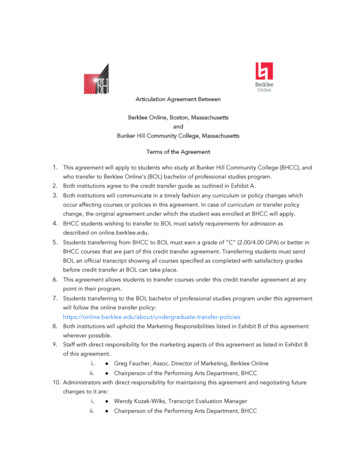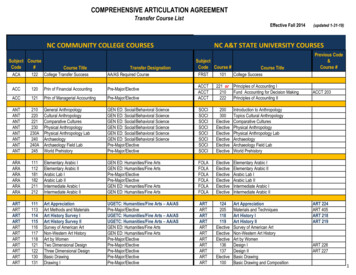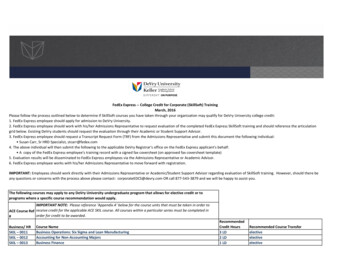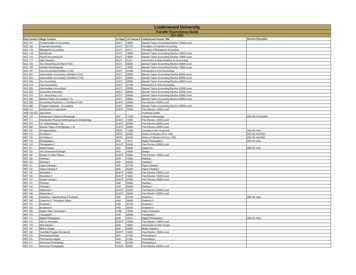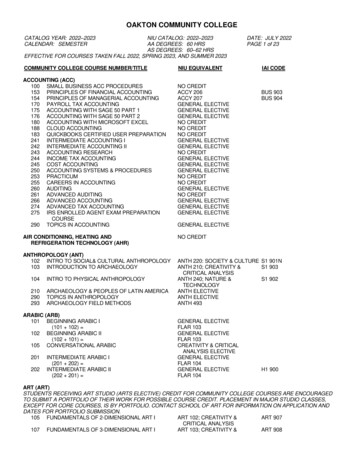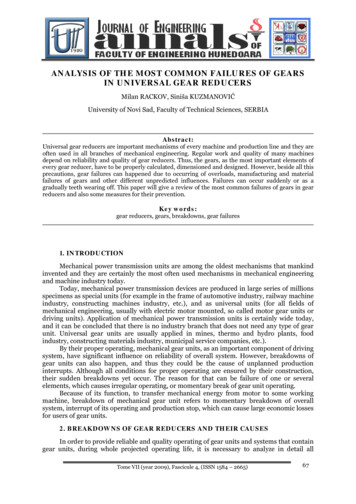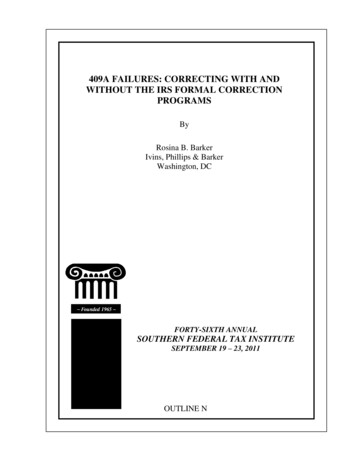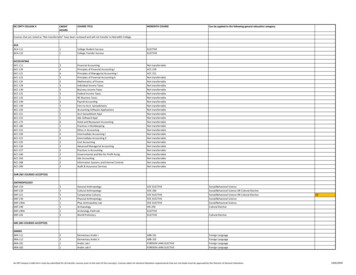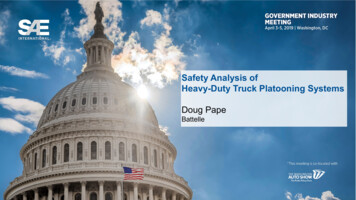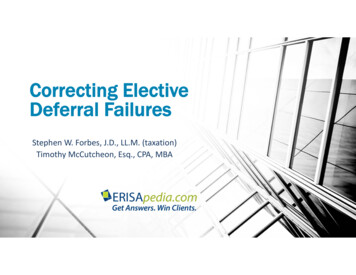
Transcription
Correcting ElectiveDeferral FailuresStephen W. Forbes, J.D., LL.M. (taxation)Timothy McCutcheon, Esq., CPA, MBA
Your Presenters Today Stephen W. Forbes, JD, LLM Tim McCutcheon, JD, CPA, MBA2
Correcting Elective Deferral Failures Facilitator:Chuck Gouge Question Board ModeratorMaureen Pesek3
During the Webinar All attendees’ lines are muted Question board available and monitored Mr. Forbes will post answers to questions onERISApedia.com/webcasts Slides and a recording of the webinar will be available fromERISApedia.com/webcasts4
CE Credit ERPA/ASPPA/NIPA Will receive certificate by email in several days ERPA will take longer (please be patient) Please check spam folderAny questions, email: support@erisapedia.com5
401(k) Plan Elective DeferralFailures
Common Elective Deferral Failures Failure to implement deferral election. The employee makes a deferralelection but the employer fails to implement the participant’s deferralelection. and Improper exclusion. The employee satisfies the plan’s eligibility conditionsbut the employer fails to allow the participant to make elective deferrals.
EPCRS Correction Methods Unlike many errors where the IRS only provides guiding correctionprinciples, for these errors, the IRS provides specific correction methods To correct an elective deferral failure, EPCRS generally requires theemployer to make a corrective QNEC contribution for the missed deferralopportunity and contribution for the matching contributions (if any) To encourage employers to correct plans with elective deferral failures, theIRS amended EPCRS to add some additional safe harbor correctionmethods The additional safe harbors reduce (or, in some circumstances, eliminate) thecorrection cost Which rule an employer uses largely depends on timing of correction
Correction for improper exclusion(General Rule) The employer makes a QNEC contribution equal to the missed deferralopportunity The missed deferral opportunity is 50% of the missed deferral Traditional 401(k) plan: the missed deferral is the average ADP% of thegroup (HCE or NHCE) to which the employee belongs Safe harbor 401(k) plan: the missed deferral is the greater of: 1.3% of plan year compensation, or2.the maximum deferral percentage for which the employer provides a matchingcontribution rate that is 100% or moreThe plan calculates the missed deferral for the portion of the plan year inwhich the employee was improperly excluded
Match correction The plan must first calculate the missed deferral The employer then applies the plan’s matching formula to the misseddeferral (not the missed deferral opportunity) to determine the correctivecontribution for the match The corrective contribution is subject to statutory and plan limits For a safe harbor match, the employer makes the contribution in the formof a QMAC For a regular match, the corrective contribution may be subject to the plan’svesting scheduleDepending on when the correction is made, the QMAC may need to beadjusted for earnings Calculate earnings from the deadline for making the matching contribution
Additional Rules for Elective DeferralCorrections The plan also will need to include earnings with the corrective contribution Improper exclusion: plan uses average ADP% for the year of exclusion regardlessof whether plan uses current or prior year testing Corrective contributions are subject to plan and statutory limits (e.g., 402(g) and415) In calculating the missed deferral, plan may not use the OEE rule Correction methods do not apply until after the correction of other qualificationfailures In other words, the plan disregards improperly excluded EEs or EEs for whom the planfailed to implement deferral elections, in applying the ADP and ACP testsThese additional rules also apply to corrections for failure to implement deferralelection.
401(k) Plan Example (improper exclusion) Company X maintains a 401(k) plan The plan administrator misapplied the eligibility requirements and delayed Dan’sentry into the plan until July 1, 2017 Dan should have entered the plan on January 1, 2017 Dan’s compensation for the plan year was 50,000 The average ADP% for the NHCEs was 3.5% Plan’s matching formula is 100% of elective deferrals not exceeding 3% The plan corrects the elective deferral failure by making a QNEC to Dan’s account of 500 plus earnings. The calculation is as follows: 875 (3.5% x 25,000) missed deferralX 50% 437.50 missed deferral opportunity The employer also would provide a corrective contribution equal to 750 for thematching contribution on the missed deferral
Safe Harbor 401(k) Plan Example (improperexclusion) Company X maintains a safe harbor 401(k) plan with a matching formula of100% of compensation not exceeding 4% of compensation The plan administrator misapplied the eligibility requirements and delayed Ann’sentry into the plan until July 1, 2017Ann should have entered the plan on January 1, 2017Ann’s compensation for the plan year was 50,000The plan corrects the elective deferral failure by making a QNEC to Ann’s account of 500 plus earnings. The calculation is as follows: 1000 (4% x 25,000) missed deferralX 50% 500 missed deferral opportunity The employer also would provide a corrective QMAC contribution equal to 1,000 for the matching contribution on the missed deferral
Failure to Implement Deferral Election(General Rule) One of the administrative challenges in maintaining a 401(k) plan is timely andproperly implementing participants’ deferral election or a change in the deferralelection If an employer fails to implement a participant’s deferral election, theparticipant will receive all of his/her normal compensation instead of havingthe compensation deferred The employer will need to make a corrective contribution to the participant’saccount to correct for this failure The method of correction is similar but not identical to the correction for animproper exclusion of an eligible employee Unlike the improper exclusion correction, in the case of a failure to implementthe deferral election, the plan knows the participant’s deferral election The participant’s deferral election forms the basis of the correction
Correction Method (General rule) With respect to a failure to implement a deferral election, the correctionmethod is the same as it is for a traditional 401(k) plan - the plan correctsby making a QNEC contribution equal to the “missed deferral opportunity“ Missed deferral opportunity 50% of the “missed deferral" Missed deferral the participant’s deferral election applied to thecompensation for the period of time for which the plan failed to implementthe election Same calculation for traditional and safe harbor 401(k) plansThe employer also would need to include earnings with the correctivecontribution
Example Company X maintains a calendar year 401(k) plan Ben made a 5% deferral election, effective January 1, 2017 Dan’s monthly compensation for 2017 was 5,000 The plan administrator failed to implement the election and the error wasnot caught until May 1, 2017 The plan would correct the failure by making a QNEC to Ben’s account inthe amount of 500 plus earnings. The calculation is as follows: 1,000 (5% x 20,000) – missed deferralx 50% 500 – missed deferral opportunity Safe result if it were a safe harbor 401(k) plan
Roth Deferral Failure The employer still corrects bymaking a QNEC contribution to theparticipant’s account
Failure To Implement: Match Correction As with the correction for an improper exclusion, the plan will apply theplan’s matching formula to the missed deferral (not the missed deferralopportunity) The plan first calculates the missed deferral Then, applies the plan’s matching formula to the missed deferral todetermine the corrective contribution for the matching formula The corrective contribution is subject to statutory and plan limits If match is a safe harbor match, the contribution will be in the form of a QMAC.Otherwise, the contribution is subject to plan’s vesting scheduleThe employer also will include earnings with respect to the correctivecontribution
Example Assume the same facts as in the previous example except the plan alsoincludes a matching formula of 100% of elective deferrals not exceeding4% of compensation for the plan year To correct, the plan applies the matching formula to the missed deferrals(100% of 800) The employer will make a matching contribution of 800 Depending on when the correction occurs, the contribution may need to beadjusted for earningsIf the plan were a safe harbor 401(k) plan and the match were a safeharbor match, the matching contribution would need to be a QMAC
Example Assume the same facts as in the previous two examples except the planalso includes a matching formula of 100% of elective deferrals notexceeding 6% of compensation for the plan year Failed to implement 5% deferral election for 4 months Dan’s compensation 5,000/month The match is subject to a vesting schedule Missed deferral 1,000Dan also will receive an additional corrective contribution of 1,000 (100%x 1,000 [5% x 20,000]) The corrective contribution will be subject to the plan’s vesting schedule Possible adjustment for earnings
Brief Exclusion Rule
Non-Safe Harbor Correction Method Under the non-safe harbor rule, an employer may correct an improper exclusionelective deferral failure without making a corrective QNEC contribution for themissed deferrals if the employer satisfies the following conditions:1.The employee has the opportunity to make elective deferral under the planfor a period of at least the last 9 months of the plan year (i.e., electivedeferral failure is 3 months or less).2.The employee has the opportunity to make elective deferrals in an amountnot less than the maximum amount that would have been permitted absentthe failure. and3.If the participant would have been entitled to a matching contribution on themissed deferrals, the employer makes a corrective contribution for the matchequal to the matching contributions that would have been allocated if themissed deferrals would have been contributed.Note: The non-safe harbor correction method for the brief exclusion rule onlyapplies to an improper exclusion
Example Company X maintains a 401(k) plan Don is eligible on January 1, 2017 but he is informed he is not eligible X catches the error on March 1, 2017 and allows Don to commence makingelective deferrals The non-safe harbor rule is available (i.e., no need to make a correctivecontribution for the missed deferrals) because Don has at least 9 monthsleft in the plan year to make up elective deferrals If the plan has a matching formula, X, however, will need to make acorrective contribution for the match
Example Company X maintains a 401(k) plan Don is eligible on January 1, 2017 and makes a deferral election of 4% ofcompensation X fails to implement the election until March 1, 2017 The non-safe harbor brief exclusion rule is not available to correct becauseit only applies to an improper exclusion However, X may correct under the safe harbor brief exclusion rule
Example Company X maintains a safe harbor 401(k) plan with a periodic safe harbormatch of 100% of elective deferrals not exceeding 4% of compensation Don (compensation: 5,000/month) was improperly excluded from the plan forthe first two months of the plan year The missed deferral is 400 (4% x 10,000) X corrected the failure on March 1, 2017X does not need to make a corrective QNEC contribution for the misseddeferrals because of the brief exclusion rule Don can increase his deferrals during the last 10 months to make up for theimproper exclusion for the first two months of the plan year However, X must make a corrective QMAC contribution of 400 (100% x 400 [4% missed deferrals x 10,000]) Note: Same result in a traditional 401(k) plan but the match is subject tothe plan’s vesting schedule
Safe Harbor Brief Exclusion Rule Under this safe harbor correction method, an employer may correct an elective deferral failure(failure to implement or an improper exclusion) without making a QNEC for the misseddeferrals if the employer satisfies the following conditions:1.Correct deferrals begin no later than (1) the first payroll date on or after the last day of thethree-month period that begins when the failure first occurred; or (2) if the employer wasnotified by the affected participant, the first payroll date on or after the end of the monthafter the notification. Note: For a failure to implement a deferral election, the employer simply implements thedeferral election. For an improperly excluded employee, the employer would need tocommunicate the deferral option and implement the participant’s election, if any.2.The employer provides a notice of the failure to the affected participants not later than 45days after the date on which the employer implements the participant’s deferral election.and3.If the participant would have been entitled to a matching contribution on the misseddeferrals, the employer makes a corrective contribution equal to the matching contributionsthat would have been allocated if the missed deferrals would have been contributed. Note: The benefit of the safe harbor rule is that rule can be used regardless of the type of elective deferralfailure and when during the plan year it occurs while the non-safe harbor rule only is available for improperexclusion and if the failure occurs during the first three months of the plan year. The advantage of the nonsafe harbor rule is that it does not have a notice requirement.
Example – Failure to implement Company X maintains a 401(k) plan with a periodic match of 100% ofelective deferrals not exceeding 4% of compensation Emma makes a 4% deferral election (compensation: 5,000/month) on herentry date of July 1, 2017 but X failed to implement the election until September1, 2017 X need not make a corrective QNEC contribution for the missed deferralsbecause of the brief exclusion safe harbor rule However, X must make a corrective contribution of 400 plus earnings (100% x 400 [4% missed deferrals x 10,000]) for the match Note: Same result in a safe harbor 401(k) plan but the corrective contribution forthe match would need to be a QMAC
Example – Improper exclusion Assume the same facts in the previous question except X improperlyinformed Emma that she was not eligible on July 1, 2017 X discovered the error and allowed her to make elective deferrals on September1, 2017 X does not need to make a corrective QNEC contribution because of the briefexclusion safe harbor rule However, X must make a corrective contribution of 400 plus earnings (100% x 400 [4% missed deferrals x 10,000]) for the match
Elective Deferral Failure(between 3 months and 2 years)
Safe Harbor Correction Method For elective deferral failures (both types) that have not been corrected within the threemonth period following the date the error first occurred Under this safe harbor, an employer may correct an elective deferral failure by making acorrective QNEC contribution of 25% (rather than the normal 50% corrective contribution)provided the employer satisfies the following conditions:1.The employer provides the employee the opportunity to make elective deferrals underthe plan not later than the earlier of (1) the last day of the second plan year followingthe plan year in which the failure occurred, or (2) if the employer was notified of thefailure by the affected employee, the first payroll date on or after the end of the monthafter the notification.2.The employer provides a notice of the failure to the affected participants not later than45 days after the date on which the employer implements the participant’s deferralelection. and3.If the participant would have been entitled to a matching contribution on the misseddeferrals, the employer makes a corrective contribution (plus earnings) equal to thematching contributions that would have been allocated if the missed deferrals wouldhave been contributed.
Example Company X maintains a safe harbor 401(k) plan with a periodic safe harbormatch of 100% of elective deferrals not exceeding 4% of compensation Ben makes a 5% deferral election (compensation: 5,000/month) on his entrydate of July 1, 2017 but X failed to implement the election until January 1, 2018. To correct, X needs to make a corrective QNEC contribution for the misseddeferrals equal to 375 plus earnings (25% x 1,500 missed deferrals [5% x 30,000]) because of the safe harbor rule X also must make a corrective QMAC contribution of 1,200 (100% x 1,200[4% missed deferrals x 30,000]) Note: The result would have been the same in a traditional 401(k) plan but thecorrective matching contribution would have been subject to the plan’s vestingschedule.
Example Assume the same facts in the previous question but X improperly informedBen that he was eligible on January 1, 2018 rather than his correcteligibility date of July 1, 2017 X discovered the error and corrected it as follows: X calculates the missed deferrals to be 1,200 (4% [highest level of deferrals atwhich the plan matches at the 100% rate] x 30,000) X makes a corrective QNEC contribution of 300 plus earnings (25% x 1,200[4% missed deferrals) X also must make a corrective QMAC contribution of 1,200 (100% x 1,200[4% missed deferrals x 30,000]) to correct the match failure
Example (Traditional 401(k) Plan) Assume the same facts in the previous question except the plan is atraditional 401(k) plan (improper exclusion) X improperly informed Ben (earning 5,000/month) that he was eligible onJanuary 1, 2018 rather than his correct eligibility date of July 1, 2017 The average ADP% for the NHCEs was 3.5%X discovered the error and corrected it as follows: X calculates the missed deferrals to be 1,050 (3.5% [average ADP%] x 30,000) X makes a corrective QNEC contribution of 262.50 plus earnings (25% x 1,050 [3.5% missed deferrals) X also must make a corrective contribution of 1,050 (100% x 1,050 [3.5%missed deferrals x 30,000]) to correct the match failure
Notice Requirement for Safe HarborCorrections To satisfy the notice requirement under the two safe harbors for correctingelective deferral failures, the notice must include the following information:1.General information regarding the failure, such as the percentage of eligiblecompensation that should have been deferred and the approximate date thatthe compensation should have begun to be deferred.2.A statement that the appropriate amounts have begun to be deducted fromcompensation and contributed to the plan.3.A statement that corrective allocations have been made (or will be made).Information relating to the date and the amount of corrective allocationsneed not be provided.4.An explanation that the affected participant may increase his/her deferrals inorder to make up for the missed deferral opportunity, subject to the 402(g)limits.5.The name of the plan and plan contact information.
Safe Harbor Correction for a 401(k) planwith an Automatic Contribution Feature EPCRS provides a safe harbor correction method for a 401(k) plan that includes an automaticcontribution arrangement Under the safe harbor, the employer does not have to make a corrective contribution for anelective deferral failure (failure to implement and improper exclusion) in a 401(k) plan with anautomatic contribution arrangement provided the following conditions are satisfied:Correct elective deferrals begin by the first payroll date on or after the earlier of:1.a)9½ months after the end of the plan year in which the failure first occurred; orb)The last day of the month after the month the affected employee first notified the employer of thefailure.2.The employer provides a notice of the failure to the affected participants not later than 45days after the date on which the correct deferrals begin. and3.If the eligible employee would have been entitled to additional matching contributions onthe missed deferrals, the employer makes a corrective allocation equal to the matchingcontributions that would have been allocated on the missed deferrals. These contributionsmust be made within the two year timeframe for correcting significant operational failures.
Example Company X maintains a QACA with the matching contribution formula(100% on the 1% of deferrals and 50% match on deferrals between 1% and6%) Ann becomes eligible for the plan on January 1, 2017 Ann makes neither an affirmative election nor a contrary election Ann’s compensation is 5,000/month X fails to implement the 3% automatic elective deferral for Ann until January 1,2018 X will not need to make a corrective contribution for the 2017 missed deferrals However, X will need to make a corrective allocation of 1,200 for the matchingcontributions on the missed deferrals (2% [100% x 1% 50% on the next 2% ofdeferrals] x 60,000) X also will need to provide Ann with a notice
Calculation of Earnings for 401(k) planswith Automatic Contribution Features For 401(k) plans with automatic contribution features that correct electivedeferral failures using the safe harbor method of correction The employer may calculate the earnings on the corrective contributions byusing the plan’s default investment alternative if the participant has notmade an investment election under the plan However, if the default investment alternative has a loss, the employer maynot reduce the required corrective contribution
Notice Requirement for Corrections of 401(k)Plans With Automatic ContributionArrangements To satisfy the notice requirement under the safe harbor for 401(k) plans with automaticcontribution arrangements, the notice must include the following information:1.General information regarding the failure, such as the percentage of eligiblecompensation that should have been deferred and the approximate date that thecompensation should have begun to be deferred.2.A statement that the appropriate amounts have begun to be deducted fromcompensation and contributed to the plan.3.A statement that corrective allocations relating to missed matching contributions havebeen made (or will be made). Information relating to the date and the amount ofcorrective allocations need not be provided.4.An explanation that the affected participant may increase his/her deferrals in order tomake up for the missed deferral opportunity, subject to the 402(g) limits.5.The name of the plan and plan contact information.
Sunset of Safe Harbor for Correction Method forPlans with Automatic ContributionArrangements The safe harbor correctionmethods for plans with automaticcontribution arrangements areavailable with respect to failuresbegin on or before December 31,2020 The Revenue Service will thenreview the safe harbors todetermine whether they should becontinued or modified
Comparison: Elective Deferral Failure CorrectionsCorrection TimePeriodCorrectiveContributionsNotice RequiredNon-safe harborBrief Exclusion RuleFirst 3 months ofthe plan year0%NoSafe Harbor BriefExclusion RuleRolling 3 monthperiod0%YesGeneral RuleNo limitation50%NoSafe HarborBetween 3 monthsand 2 years25%YesSafe Harbor(automaticcontributionarrangements)Earlier of: 9½0%months after the PYof failure or the lastday of the monthfollowing EEnotificationYes
Corrective ContributionsTraditional 401(k) PlanSafe Harbor 401(k) PlanMissed deferral (improperexclusion)Average ADP% for thegroup to which the EEbelongs (NHCE or HCE)The greater of (1) 3%, or (2)the highest rate ofdeferrals at which the planmatches 100%Missed deferral (failure toimplement)Participant’s deferralelectionParticipant’s deferralelectionMatchCorrective contributionsubject to plan’s vestingscheduleCorrective contribution forSH match must be a QMAC;other matchingcontributions subject toplan’s vesting schedule
Failure To Implement a Change in DeferralElection Not specifically discussed inEPCRS The principals as well as the safeharbors should apply when theemployer fails to implement anincrease in the participant’sdeferral election The employer makes a correctiveQNEC contribution for the misseddeferral opportunity and calculatesany match on the missed deferral
Example Company X maintains a safe harbor 401(k) plan that provides a safe harbormatch of 100% of elective deferrals not exceeding 4% of compensation Effective July 1, 2017, Mary increases her deferral election from 3% to 4%Mary’s compensation is 5,000/monthThe plan fails to implement the change until January 1, 2018 The missed deferral is 300 (1% x 30,000) Since the failure was discovered and corrected within the safe harbor period(between 3 months and two years), the corrective QNEC contribution for themissed deferral opportunity will be 75 ( 300 x 25%) The corrective QMAC contribution to correct the matching failure is 300 Earnings adjustment Note: If the employer had caught the error within three months, it could havetaken advantage of the brief exclusion safe harbor and avoided making theQNEC contribution for the elective deferral failure. The employer would stillhave needed to make a corrective contribution for the matching contributions.
Failure To Implement Decrease inParticipant’s Deferral Election Not addressed in EPCRS The appropriate correction would be for the plan to return the inappropriatelywithheld contributions to the participant If there is enough time left in the plan year, the employer could decrease thedeferrals for the balance of the plan year so that the participant’s annualdeferrals equal the amount of deferrals the participant intended Of course, the employer would need to make certain the participant received thematch he/she should have received if the change had been properly implemented The plan should report the returned contributions on a Form 1099-R with acode “7” for other distributions so the participant is not subject to the 10%penalty With respect to any employer contribution allocated in error, the plan eithershould allocate to other participants if they have not received their fullallocation or forfeit the allocation and use it in the next plan year
Earnings Calculations forCorrective Contributions
Earnings adjustment General rule: whenever a correction requires a corrective contribution, thecontribution should be adjusted for earnings Reasonable estimates permitted Generally, employer does not adjust for lossesPeriod of failure: is the period from the date the failure began through thedate of correction In the case of an exclusion of an eligible employee, the beginning date is thedate on which contributions of the same type were made to the planSafe harbor match and nonelective contributions are due 12 months afterthe close of the plan year If the employer corrects within the time period, no earnings adjustment would benecessary
Elective Deferrals and MatchingContribution 401(k) or (m): For administrative convenience, the employer may treat the dateon which contributions would have been made as the midpoint of the plan year(or the midpoint of the portion of the plan year) for which failure occurred Alternatively, the employer may treat the date on which contributions would havebeen made as the first day of the plan year (or portion of the plan year) duringwhich the employee was excluded, provided the earnings rate is one-half of theearnings rate
Earnings Rate Multiple investment funds: The rate is based on the participant’s investment choices If most of the employees are NHCEs, the rate can be the fund with the highestrate of return for the period failure If the employee has not made an investment choice, the rate can be the averageof the rates earned by all of the funds weighted by the portion of the plan assetsinvested in the various funds
Earnings Calculations for Safe HarborCorrections for Elective Deferral Failures Alternative method for calculating earnings for elective deferral failures,including for corrective contributions for the matching contributions If an affected employee has not affirmatively made investment choices underthe plan, the employer may calculate the missed earnings on the basis of theplan’s default investment alternative Any accumulated losses will not result in a reduction in the required correctivecontributions Plan also may use the Earnings adjustment method in Section 3, Appendix B orEPCRS
Corrective QNEC Contribution (misseddeferral opportunity) Prior to the issuance of the safe harbors for elective deferral failures underEPCRS, the corrective QNEC contribution was 50% With the issuance of the safe harbors, the corrective QNEC contributionpercentage depends on when the correction takes placeCorrection takes placeCorrective QNEC %First 3 months after the beginning ofthe plan year0%; but would need to make acorrective match contribution if theplan had a matchBetween 3 months and 2 years afterthe beginning of the plan year25%; Also would need to contribute acorrective match contribution if planhas a matchAfter 2 years50%; Also would need to contribute acorrective match contribution if planhas a match
Plan includes a match feature If the plan includes a matching contribution feature, the employer wouldneed to make a corrective contribution for the match by applying the plan’smatching formula against the missed deferrals (not the missed deferralopportunity) If the plan provided a safe harbor nonelective contribution, the correctionwould include that contribution With the corrective contributions, the employer also may need to make acontribution to make-up for the lost earnings
Contact Information Author of the Plan Corrections: answers to your questions Stephen W. Forbes (720) 799-7039 stephen.forbes32@gmail.comPublisher of ERISApedia.com: Timothy M. McCutcheon (612) 605-2266 tmm@erisapedia.com / sales@erisapedia.com
CE Credit ERPA/ASPPA/NIPA Will receive certificate by e
Correction for improper exclusion (General Rule) The employer makes a QNEC contribution equal to the missed deferral opportunity The missed deferral opportunity is 50% of the missed deferral Traditional 401(k) plan : the missed deferral is the average ADP% of the group (HCE or NHCE) to which the employee belongs Safe harbor 401(k) plan: t he missed deferral is the greater of:
